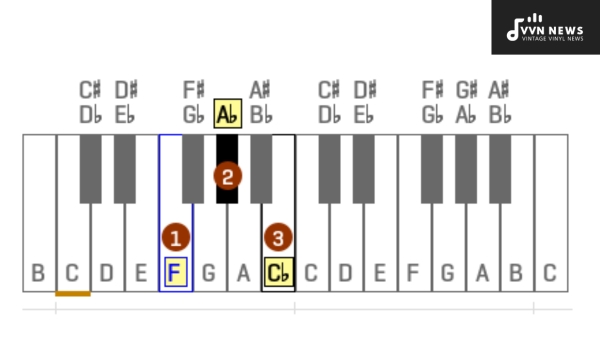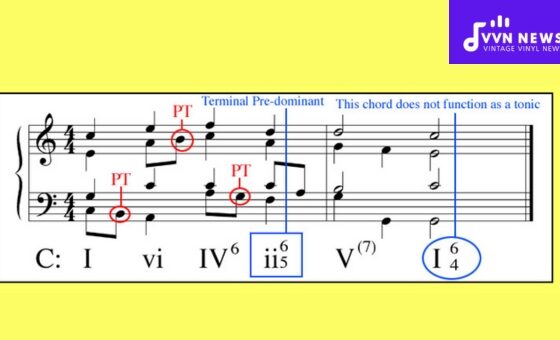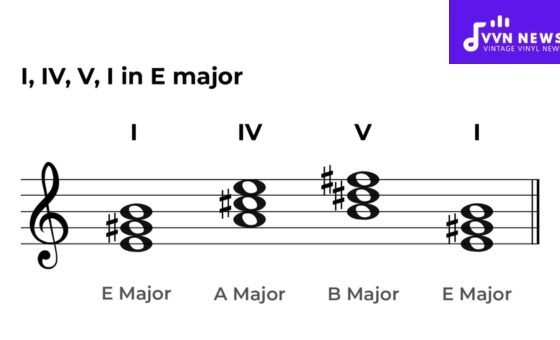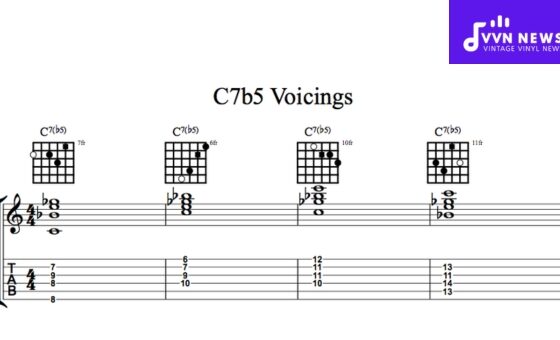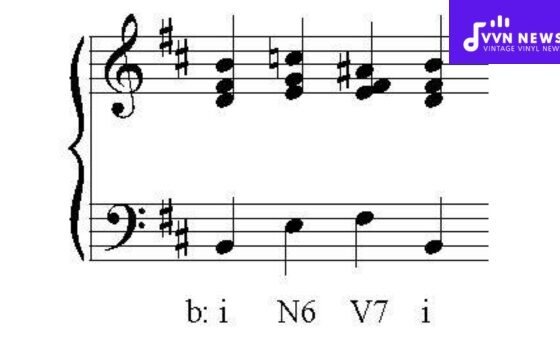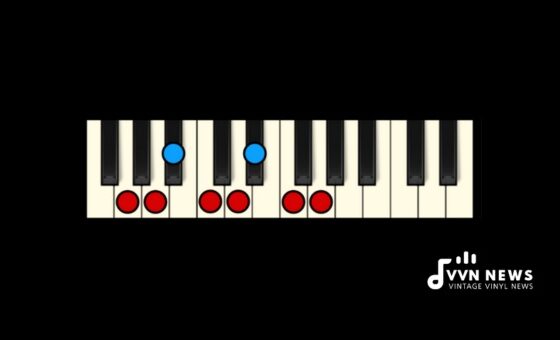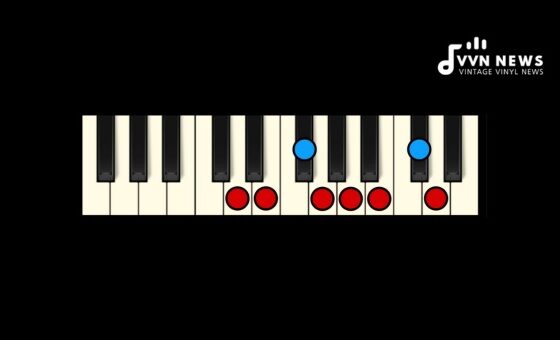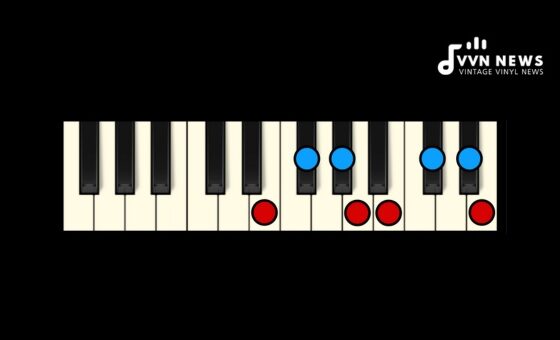Imagine yourself in a room full of instruments; your fingers are itching to create a melody that’s going to linger.
In pursuit of this, you’ve wholeheartedly decided to familiarize yourself with the art of music theory.
Selecting the right chord is like choosing the perfect words to express your emotions through the universal language that is music.
One such chord you may consider using is the F diminished triad, a powerful tool for creating tension and resolution within your compositions.
In music theory, there are major and minor chords that are commonly used as they have a stable, satisfying sound.
Then there’s another group called diminished chords which, when used correctly, bring an intriguing element to your music.
The F diminished triad falls under this group. Rather than shying away from its seemingly complex nature, let’s embrace its eccentricity and discover how it could be an extraordinary addition to our melodies.
What is the F Diminished Triad?
The F Diminished Triad is a three-note chord that consists of the notes F, Ab, and Cb.
It is constructed by taking the root note F and stacking a minor third interval above it with Ab, followed by another minor third interval with Cb. The resulting sound of the F Diminished Triad is tense and dissonant.
In terms of music theory, the F Diminished Triad is important because it can serve as a substitute for dominant chords, providing tension and leading to resolution. It is commonly used in jazz and classical music, adding complexity and color to compositions.
On guitar, the F Diminished Triad can be played in several positions along the fretboard using different fingerings. On piano, you can play the chord by placing your thumb on F, your middle finger on Ab, and your pinky finger on Cb.
When it comes to chord progressions, the F Diminished Triad can be used as a substitute for dominant 7th chords in progressions such as ii-V-I in jazz. It can also be used to create chromatic movement or add tension in a variety of musical genres.
The inversions of the F Diminished Triad change the order of its notes while still maintaining its structure. In first inversion, Ab becomes the root note; in second inversion, Cb becomes the root note.
To practice and master the F Diminished Triad, begin by memorizing its structure and different voicings on your instrument.
Incorporate it into various musical exercises, such as arpeggios or chord progressions. Experiment with different contexts and styles of music to fully explore its potential.
How is the F Diminished Triad Constructed?
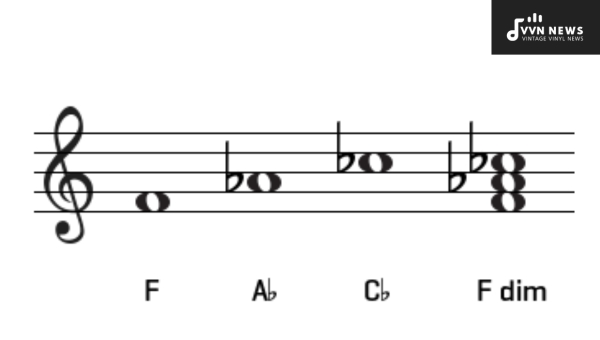
The F Diminished Triad is constructed by taking the root note F and stacking a minor third interval above it with Ab, followed by another minor third interval with Cb. The resulting chord consists of three notes: F, Ab, and Cb.
The term “minor third interval” refers to a distance of three half steps or three frets on a guitar or piano. In the case of the F Diminished Triad, this means that Ab is three half steps above F, and Cb is three half steps above Ab.
To visualize this on the guitar, you can play the F Diminished Triad by placing your index finger on the first fret of the low E string (which is F), your middle finger on the fourth fret of the A string (which is Ab), and your ring finger on the second fret of the D string (which is Cb).
On piano, you can play the F Diminished Triad by positioning your thumb on F, your middle finger on Ab, and your pinky finger on Cb.
The structure of the F Diminished Triad creates a tense and dissonant sound due to its two stacked minor thirds. This dissonance makes it useful for adding tension in compositions or leading to resolution.
Understanding how the F Diminished Triad is constructed allows you to identify its distinct sound in music and utilize it effectively in chord progressions and improvisation.
Also Read: A Flat Minor Blues Scale [Understanding The Magic Of Music]
Why is the F Diminished Triad Important in Music Theory?
The F Diminished Triad holds significant importance in music theory due to its unique characteristics and its ability to add tension and color to compositions. Here are a few reasons why the F Diminished Triad is important:
- Tension and resolution: The F Diminished Triad creates tension, making it useful for building anticipation and leading to a resolution. Its dissonant sound can evoke emotions and add depth to a musical piece.
- Substitution for dominant chords: The F Diminished Triad can serve as a substitute for dominant chords, providing an alternative way to create tension in chord progressions. This substitution can introduce unexpected harmonic turns and create interesting musical effects.
- Enhanced harmonic complexity: Incorporating the F Diminished Triad into your compositions can enrich your harmonic palette. Its dissonant sound adds complexity and interest, pushing the boundaries of traditional harmony.
- Jazz and classical applications: The F Diminished Triad is commonly used in jazz and classical music genres. In jazz, it is often employed as a substitute for dominant 7th chords, contributing to the genre’s characteristic harmony. Classical composers also utilize this triad to create tension and evoke certain moods within their compositions.
- Chromatic movement: The F Diminished Triad can be used to create chromatic movement by alternating between diminished triads in different keys or using passing diminished chords between other harmonies. This technique adds chromaticism and interest to melodies and chord progressions.
The F Diminished Triad plays an essential role in music theory by offering tension, substituting dominant chords, enhancing harmonic complexity, finding applications in jazz and classical music, as well as contributing to chromatic movement within compositions.
One of the defining characteristics of the F Diminished Triad is its unique and distinct sound.
When played, it creates a sense of tension and unease that can add a dramatic and mysterious quality to your musical compositions. The dissonance caused by the minor third intervals in the chord gives it a haunting and unresolved feel.
When you play the F Diminished Triad, you may find that it evokes a sense of suspense or anticipation in your listeners. It has a sharp, edgy sound that can create a sense of urgency or unease, depending on how it is used in your music.
The diminished quality of this triad lends itself well to certain genres such as jazz or classical music. In jazz, it is often used as a substitute for dominant chords, adding tension and leading to resolution.
In classical music, composers utilize the F Diminished Triad to create atmospheric passages or to convey darker emotions.
The F Diminished Triad is an essential tool for adding depth and complexity to your compositions.
Its distinctive sound can elevate your music, transporting your listeners into an emotional journey filled with tension and intrigue.
Also Read: B Minor Blues Scale [Discover The Power Of Emotional Music]
How Can You Play the F Diminished Triad on Different Instruments?
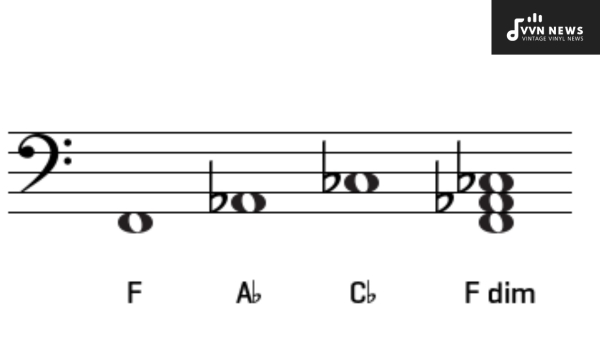
Playing the F Diminished Triad on different instruments may require different fingerings and techniques. Here’s a guide on how to play the F Diminished Triad on some common instruments:
Guitar
On guitar, you can play the F Diminished Triad in various positions and fingerings. Here are a few options:
- Open Position: Place your first (index) finger on the first fret of the low E string (F), your second (middle) finger on the second fret of the G string (Ab), and your third (ring) finger on the third fret of the B string (Cb).
- Barre Chord Shape: Barre your first finger across all six strings at the first fret to create an F chord shape. Place your second finger on the fourth fret of the A string (Ab), and your third finger on the fifth fret of the D string (Cb).
- Root Position Shape: Place your first finger on the eighth fret of the A string (F), your second finger on the ninth fret of D string (Ab), and your third finger barring across both G and B strings on the tenth frets.
Piano
On piano, you can play multiple inversions of the F Diminished Triad. Here’s how to do it:
- Root Position: Place your thumb on F, your middle finger on Ab, and pinky finger on Cb.
- First Inversion: Place your thumb on Ab, index or middle finger on Cb, and pinky finger stretching over to F.
- Second Inversion: Place your thumb or index/middle fingers over Cb, ring or pinky fingers over F, and another ring or pinky fingers over Ab.
Bass
On bass guitar, you can play various shapes for the F Diminished Triad. Here are a couple of examples:
- Low E String Root: Play the F Diminished Triad by placing your first finger on the first fret of the low E string (F), your third finger on the fourth fret of A string (Ab), and your fourth finger on the fourth fret of D string (Cb).
- A String Root: Play the F Diminished Triad by placing your first finger on the eighth fret of A string (F), your second finger on the ninth fret of D string (Ab), and your fourth finger on the ninth fret of G string (Cb).
Other Instruments
The approach to playing the F Diminished Triad may vary depending on the instrument you play. For brass, woodwind, or other stringed instruments, you can use sheet music or notation to follow along with specific fingering instructions.
Practicing these different fingerings and positions will help you become more familiar with playing the F Diminished Triad in different contexts and musical styles.
Experimenting with these shapes and voicings will expand your musical vocabulary and allow you to incorporate this unique chord into your compositions and improvisations.
Also Read: C Major Blues Scale [Master The Joyful Side Of Music Theory]
What Are the Common Chord Progressions with the F Diminished Triad?
The F Diminished Triad can be used in various chord progressions to add tension, create movement, and enhance musical compositions. Let’s explore some common chord progressions that incorporate the F Diminished Triad:
- ii-V-I Progression: In jazz music, the ii-V-I progression is a staple. It typically moves from a minor 7th chord (ii) to a dominant 7th chord (V) and resolves to a major 7th or major 6th chord (I). To add tension and color, you can substitute the V chord with the F Diminished Triad. For example, in the key of C major, you could have Dm7 – Fdim – Cmaj7.
- Chromatic Movement: The F Diminished Triad can be used to create chromatic movement within a progression. By moving up or down in minor thirds, you can create an interesting harmonic motion. For instance, you could have Fdim – Gm – Abdim – Am.
- Modal Interchange: Modal interchange involves borrowing chords from parallel scales to add flavor and variety. In this context, the F Diminished Triad can be borrowed from the parallel C harmonic minor scale. For example, in the key of C major, you could have C – Bb/F.
- Secondary Dominants: Another common use of the F Diminished Triad is as a secondary dominant leading to another chord. For instance, in the key of C major, you could have G7 – Bbdim – C.
- Diminished Cycle Progression: The diminished cycle progression involves linking diminished chords a half step apart to create movement and tension. Starting with the F Diminished Triad as an example: Fdim – Gbdim – Adim – Bbdim – C#dim – Ddim – Edim.
By incorporating these chord progressions into your compositions, you can utilize the F Diminished Triad to add sophistication and creativity to your musical arrangement.
Also Read: C Sharp Major Blues Scale [Expand Your Musical Vocabulary]
How Does the F Diminished Triad Differ from Other Triads?
The F Diminished Triad sets itself apart from other triads through its unique combination of notes and its distinct sound. Here’s a breakdown of how it differs from other common triads:
1. Structure: The F Diminished Triad is comprised of the root note (F), a minor third interval above the root (Ab), and another minor third interval above the second note (Cb). This differs from major triads, which have a major third interval between the root and second note, and minor triads, which have a minor third interval between these notes.
2. Sound: Unlike major and minor triads, which have a more consonant sound, the F Diminished Triad has a dissonant and tense quality. It creates an intense sense of anticipation, often used to build tension before resolving to a more stable chord.
3. Chord Symbol: The symbol for the F Diminished Triad is “Fdim” or “Fo.” This is different from major triads (notated as “F” or “Fmaj”) or minor triads (notated as “Fm” or “Fmin”).
4. Chord Quality: While major and minor triads are considered “stable” or “consonant,” the diminished triad is considered an unstable or dissonant chord. Its unique quality allows it to add tension and drama to musical compositions.
5. Applications: The diminished triad has several distinctive applications that set it apart from other triads. It can function as a substitute for dominant chords, create chromatic movement in chord progressions, or be used in modulations or key changes.
These differences between the F Diminished Triad and other common triadescribe in your article (major/minor), musicians can harness its unique qualities to add depth, complexity, and tension to their compositions.
What are the Inversions of the F Diminished Triad?
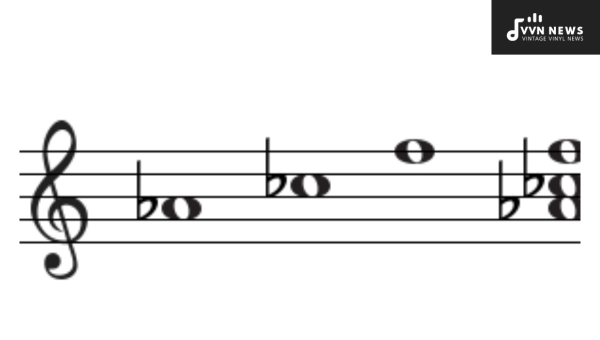
The F Diminished Triad has two inversions, each offering a unique voicing and harmonic character. Understanding and incorporating these inversions into your playing will expand your musical palette and give you more options for chord progressions and melodic ideas.
First Inversion of the F Diminished Triad
In the first inversion, the third note of the triad, Ab, becomes the root note. This inversion is denoted as Ab/F or Fdim7/A♭. It consists of the notes Ab, Cb, and F. Visually on sheet music or in tablature, this inversion is represented with the lowest note being Ab.
Second Inversion of the F Diminished Triad
In the second inversion, the fifth note of the triad, Cb, becomes the root note. This inversion is denoted as Cb/F or Fdim7/C♭. It consists of the notes Cb, F, and Ab. Visually on sheet music or in tablature, this inversion is represented with the lowest note being Cb.
By exploring both inversions of the F Diminished Triad in different musical contexts and progressions, you can create interesting harmonic textures and add tension to your compositions.
Also Read: D Flat Major Blues Scale [Add New Colors To Your Music]
FAQs About F Diminished Triad
What is the difference between the F Diminished Triad and other triads?
The F Diminished Triad differs from other triads in its structure, consisting of a root note, a minor third interval, and a diminished fifth interval.
How does the F Diminished Triad sound?
The F Diminished Triad has a tense and dissonant sound due to its diminished fifth interval. It creates a sense of tension and can add complexity and suspense to your musical compositions.
Can I play the F Diminished Triad on different instruments?
Yes, you can play the F Diminished Triad on various instruments. On guitar, you can explore different voicings along the fretboard.
What are some common chord progressions with the F Diminished Triad?
The F Diminished Triad can be used as a substitute for dominant chords in chord progressions like ii-V-I in jazz music. It can also create chromatic movement or add tension in various musical genres.
Can you explain the inversions of the F Diminished Triad?
In first inversion of the F Diminished Triad, Ab becomes the root note. In the second inversion, Cb becomes the root note. These inversions give you different ways to play and voice the chord while keeping its essential structure intact.
Conclusion
The F Diminished Triad is a versatile chord that can add tension and complexity to your musical compositions. Its dissonant sound makes it a valuable tool for creating movement and resolving to other chords.
By understanding its construction, applications, and inversions, you can confidently incorporate the F Diminished Triad into your playing.
Whether you’re a guitarist, pianist, or any other musician, exploring the F Diminished Triad will open up new possibilities for your musical expression.
